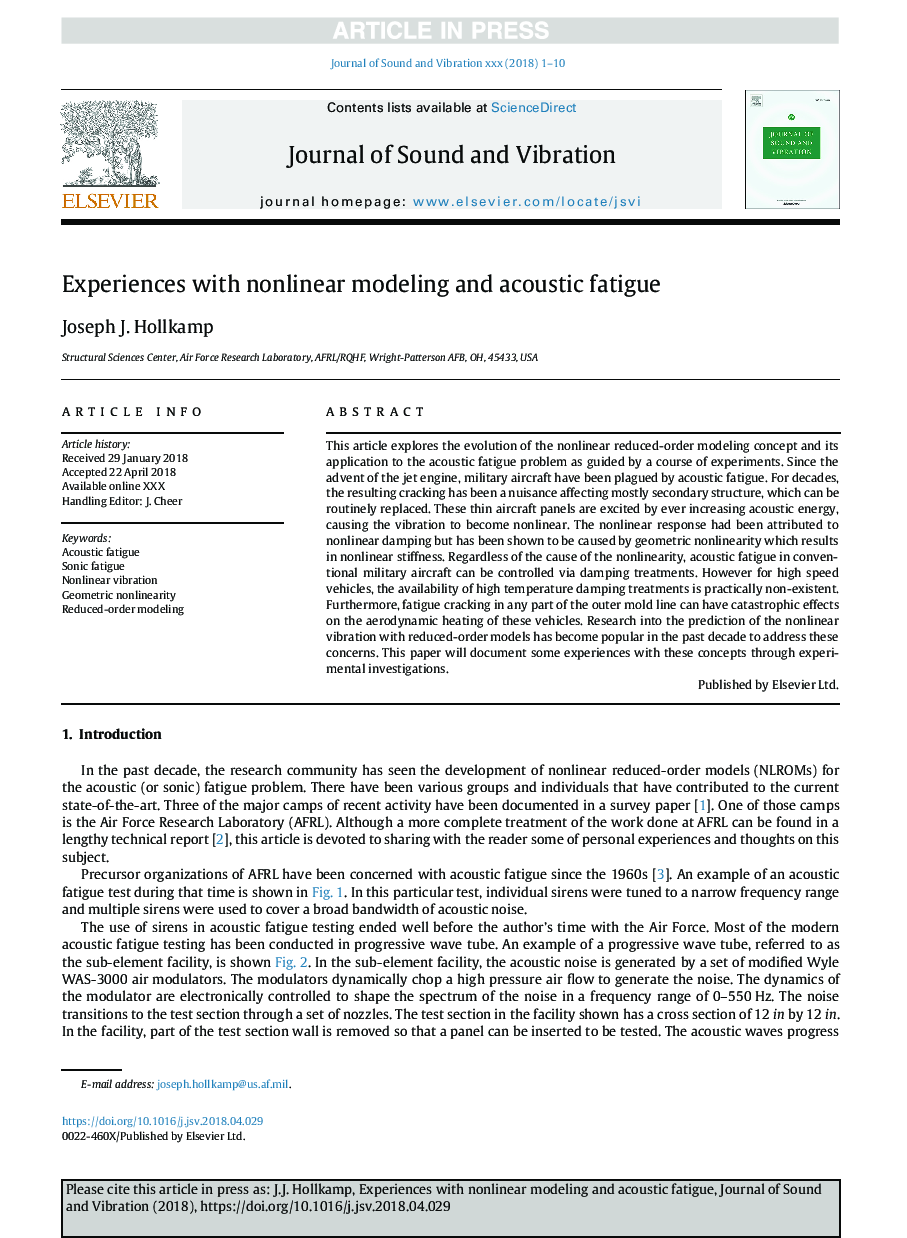| کد مقاله | کد نشریه | سال انتشار | مقاله انگلیسی | نسخه تمام متن |
|---|---|---|---|---|
| 11024176 | 1701177 | 2018 | 10 صفحه PDF | دانلود رایگان |
عنوان انگلیسی مقاله ISI
Experiences with nonlinear modeling and acoustic fatigue
ترجمه فارسی عنوان
تجربه با مدل سازی غیرخطی و خستگی آکوستیک
دانلود مقاله + سفارش ترجمه
دانلود مقاله ISI انگلیسی
رایگان برای ایرانیان
کلمات کلیدی
خستگی آکوستیک، خستگی صوتی ارتعاش غیر خطی، غیر خطی هندسی، مدل سازی کاهش یافته،
ترجمه چکیده
این مقاله به بررسی تکامل مفهوم مدل سازی فرضی غیرخطی و کاربرد آن در مسئله خستگی صوتی به عنوان هدایت یک دوره آزمایش می پردازد. از زمان ظهور موتور جت، هواپیمای نظامی با خستگی آکوستیک روبرو بوده است. در دهه های اخیر، ترک خوردگی ناشی از ناراحتی هایی است که عمدتا ساختار ثانویه را تحت تاثیر قرار می دهد که می تواند به طور مرتب جایگزین شود. این پانل های هواپیما نازک با افزایش انرژی آکوستیک هیجان زده شده است، و باعث می شود که ارتعاش تبدیل به غیر خطی شود. پاسخ غیرخطی به تغییرات غیر خطی منجر شده است اما نشان داده شده است که به دلیل غیر خطی هندسی که باعث سختی غیرخطی می شود، ناشی می شود. صرف نظر از علت غیر خطی بودن، خستگی آکوستیک در هواپیماهای نظامی متعارف می تواند با استفاده از تدابیر کمکی کنترل شود. با این حال برای وسایل نقلیه با سرعت بالا، در دسترس بودن درمان های دم درجه حرارت پایین عملا وجود ندارد. علاوه بر این، ترک خوردگی خستگی در هر بخشی از خط تولید بیرونی می تواند اثرات فاجعه آمیز بر گرمای آیرودینامیکی این وسایل نقلیه داشته باشد. تحقیق در پیش بینی ارتعاش غیرخطی با مدل های کاهش سفارش در دهه گذشته در جهت رفع این نگرش ها محبوب شده است. این مقاله با استفاده از تجربیات تجربی برخی از تجربیات این مفاهیم را مستند می کند.
موضوعات مرتبط
مهندسی و علوم پایه
سایر رشته های مهندسی
مهندسی عمران و سازه
چکیده انگلیسی
This article explores the evolution of the nonlinear reduced-order modeling concept and its application to the acoustic fatigue problem as guided by a course of experiments. Since the advent of the jet engine, military aircraft have been plagued by acoustic fatigue. For decades, the resulting cracking has been a nuisance affecting mostly secondary structure, which can be routinely replaced. These thin aircraft panels are excited by ever increasing acoustic energy, causing the vibration to become nonlinear. The nonlinear response had been attributed to nonlinear damping but has been shown to be caused by geometric nonlinearity which results in nonlinear stiffness. Regardless of the cause of the nonlinearity, acoustic fatigue in conventional military aircraft can be controlled via damping treatments. However for high speed vehicles, the availability of high temperature damping treatments is practically non-existent. Furthermore, fatigue cracking in any part of the outer mold line can have catastrophic effects on the aerodynamic heating of these vehicles. Research into the prediction of the nonlinear vibration with reduced-order models has become popular in the past decade to address these concerns. This paper will document some experiences with these concepts through experimental investigations.
ناشر
Database: Elsevier - ScienceDirect (ساینس دایرکت)
Journal: Journal of Sound and Vibration - Volume 437, 22 December 2018, Pages 437-446
Journal: Journal of Sound and Vibration - Volume 437, 22 December 2018, Pages 437-446
نویسندگان
Joseph J. Hollkamp,
